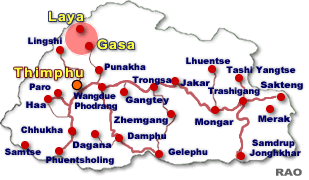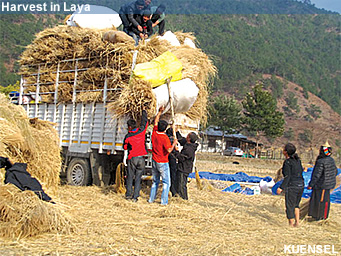| Bhutan
- Ethnic Groups & People |
 |
Bhutan People Layaps |
|
 |
Bhutan Information |
|
|
 |
|
Layaps do things differently now |

|
 |
|
With their newfound affluence, the highlanders' winter lifestyle has changed as well
Migration: Although the almost ancient ritual of nomads of Laya descending to the warmer valley in Punakha every winter continue even today, what has changed is the way they do it. From makeshifts, they have moved to imported camping tents, and from rudimentary cooking arrangement using stones and rods, it is now gas stoves.
|
|
In making the trip where they barter yak products and incense with cereals, Layaps, who reside at an altitude of 3,840m above sea level, used to live in sheds belonging to their hosts in Punakha.
Today, except for a few who use tarpaulin sheets and firewood, sophisticated tents in different colours dot the space between the police camp area and Zomlingthang.
 |
|
Thanks to the cordyceps and porter-pony businesses, highlanders carry enough money to buy food cereals and other edibles, without having to rely heavily on barter.With the money, they also buy hay and feed for their cattle and horses.
A 63-year old Layap, who arrived in Punakha two months ago, said he initially camped at Khuruthang, but shifted to Zomlingthang as he could return to Laya any time.
His 60-year-old wife and grandson, 12, live with him in the tent pitched in a paddy field.
|
|
As a child, the nomad remembered going begging for cereals with his parents, when the ration they stocked after selling incense ran out.
"We then lived in sheds belonging to our host in Punakha," he said.
As he grew, he started doing business and sold Chinese goods like blankets, flasks, cups and shoes to residents of lower valleys in Gasa and Punakha.
"But life became much better after Layaps started earning income from sale of the medicinal fungi, cordyceps and in dealing as porters," he said.
He said he comes to Punakha every winter with more than Nu 100,000, depending on the amount of cordyceps collected.
"I already bought hay and feed worth Nu 50,000 and reached it until Gasa," he said.
Besides the yak products, Layaps, in those days, also sold woven sheep wool blankets and imported tealeaves, bought from markets across the northern border and.
But with enough cash in hand, Layaps said, coming to lower altitudes is more like a holiday time.
Sonam Thinley, 18, said he and his mother came to Punakha with the money they earned from selling cordyceps.
"My mother is too old to beat the harsh cold and I have severe stomach ulcer," he said. "We buy rations with our money and spent our winter in pleasant climate."
The way people dress has also changed.Except for a few elderly women, who still wear their woven ankle-length costumes, mostly in black, which is accompanied by conical bamboo hats, most wear kira and tego.
Kinley Wangmo, 29, said she feels more comfortable in kira than in her Layap costume in Punakha.
"We wear our costume only on occasions," she said.
While most men wear pants and shirts, some young boys also have their hair dyed in fancy colours.Their hands are kept busy with latest smart phones.
Meanwhile, the winter home for more than 300 Layaps lack proper toilet and drinking water facility.As such, defecation in open spaces is a common practice.They also have to fetch water from a source some 200m away.
The trip is not just about spending money.Layaps also use the time to go to banks and save money for their children.
Dema, 21, said she makes it a point to save money for her two children every winter.
"Our children’s future will depend on the sustainability of cordyceps, and we never know what would happen," she said. "So I have to start saving money for my children."
Meanwhile, many Layaps at this time are preparing to return home, loading trucks with hay, rations and furniture.
 |
| Contributed
by Tashi Dema, Kuensel, Bhutan's National Newspaper 2014 |
| Information on Bhutan |
 |
|




